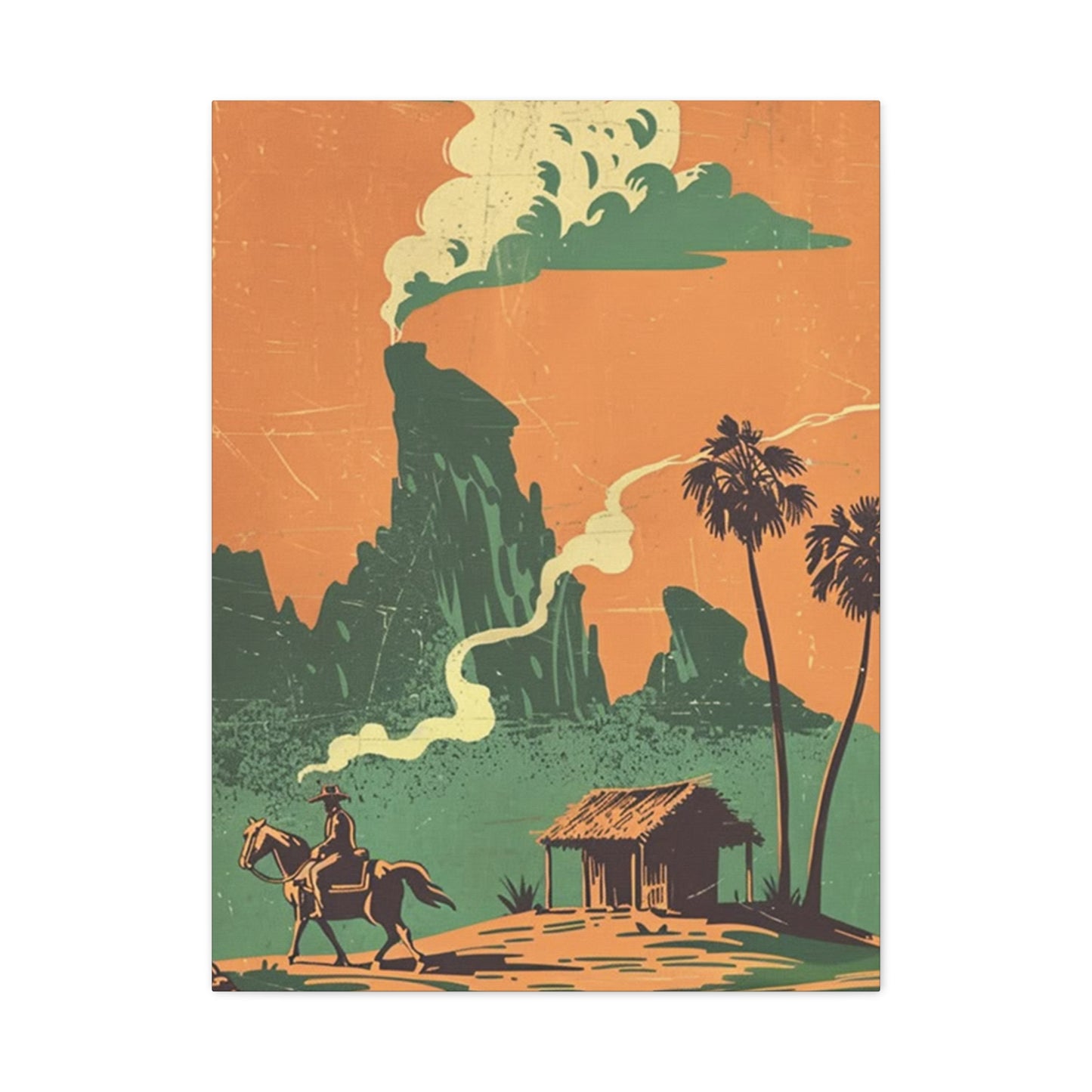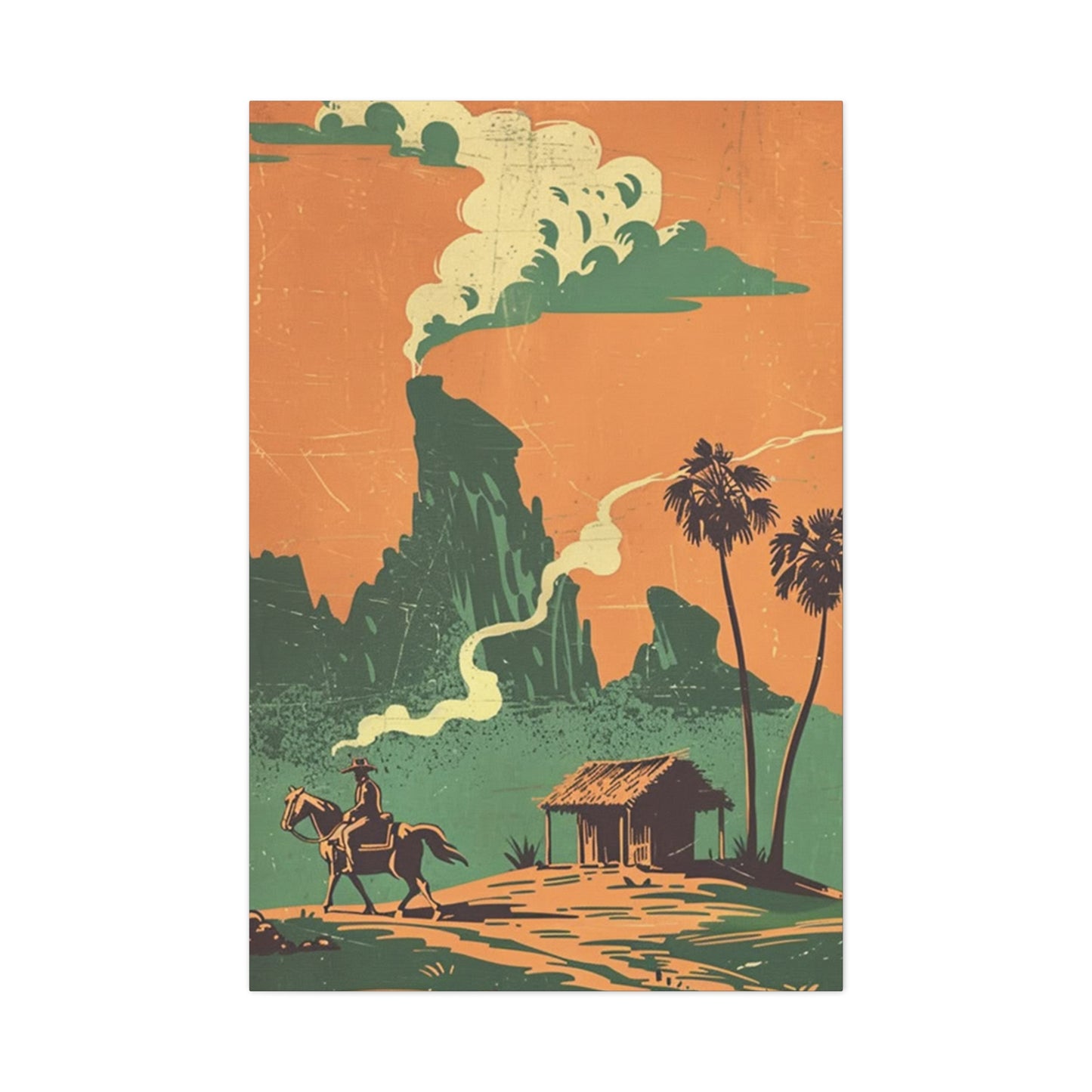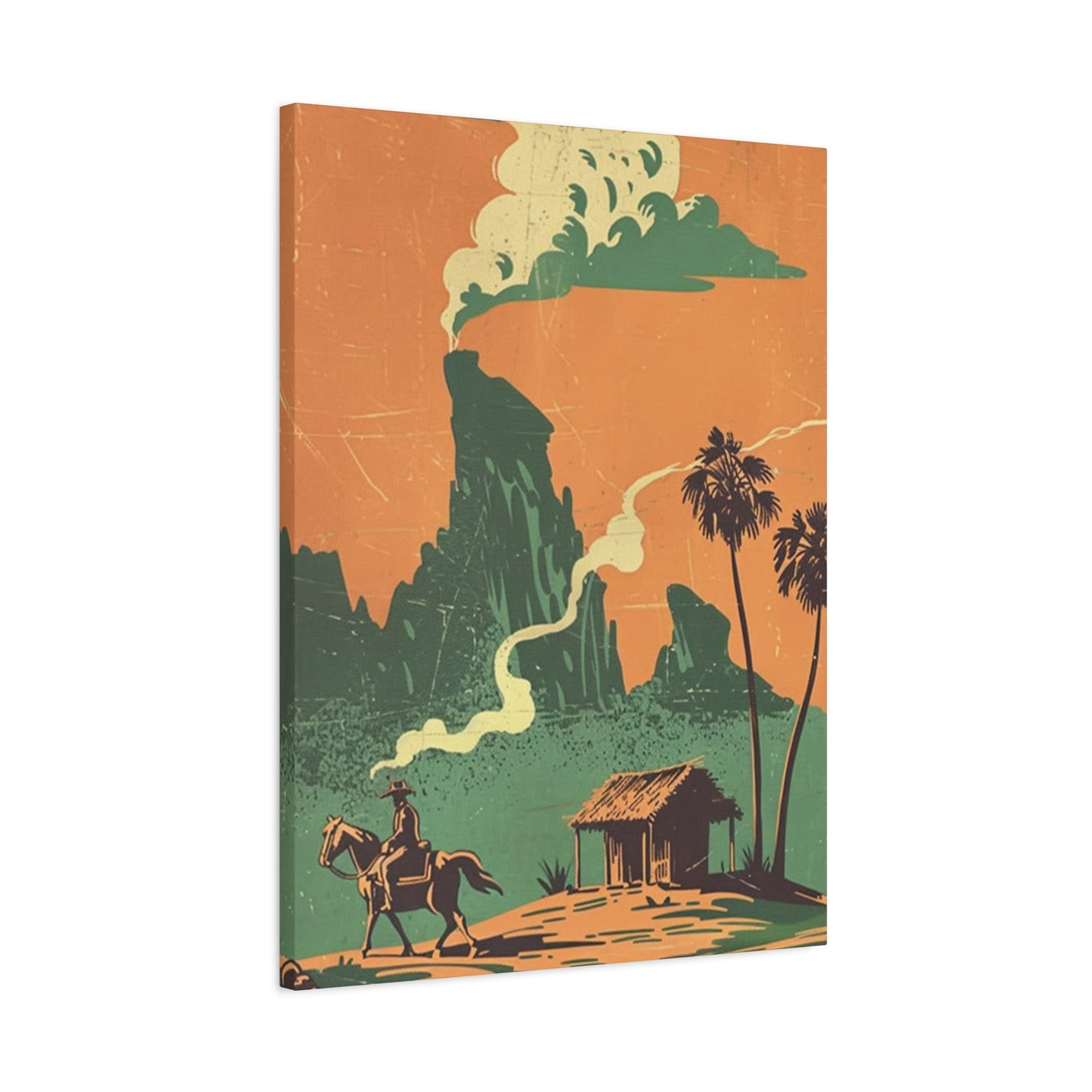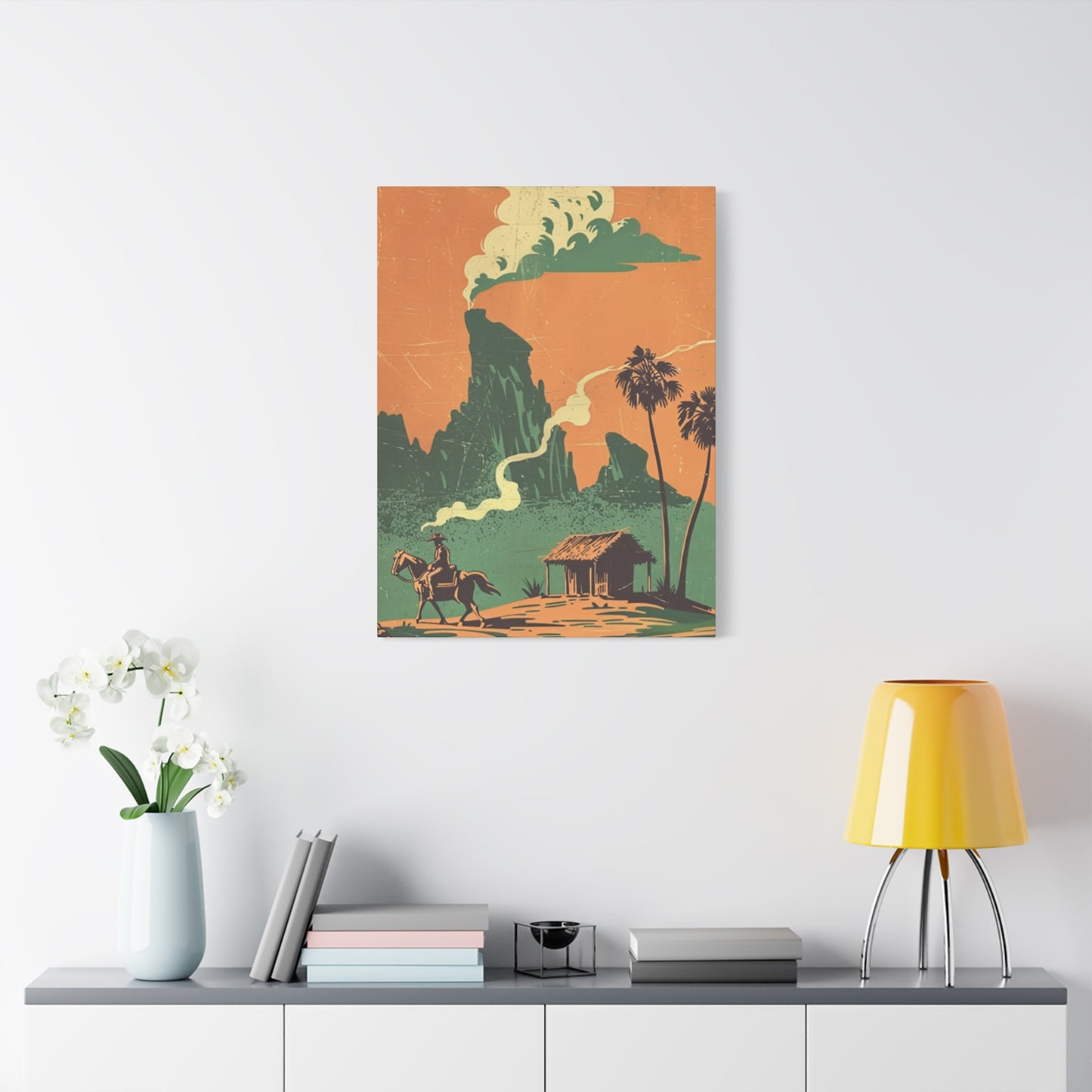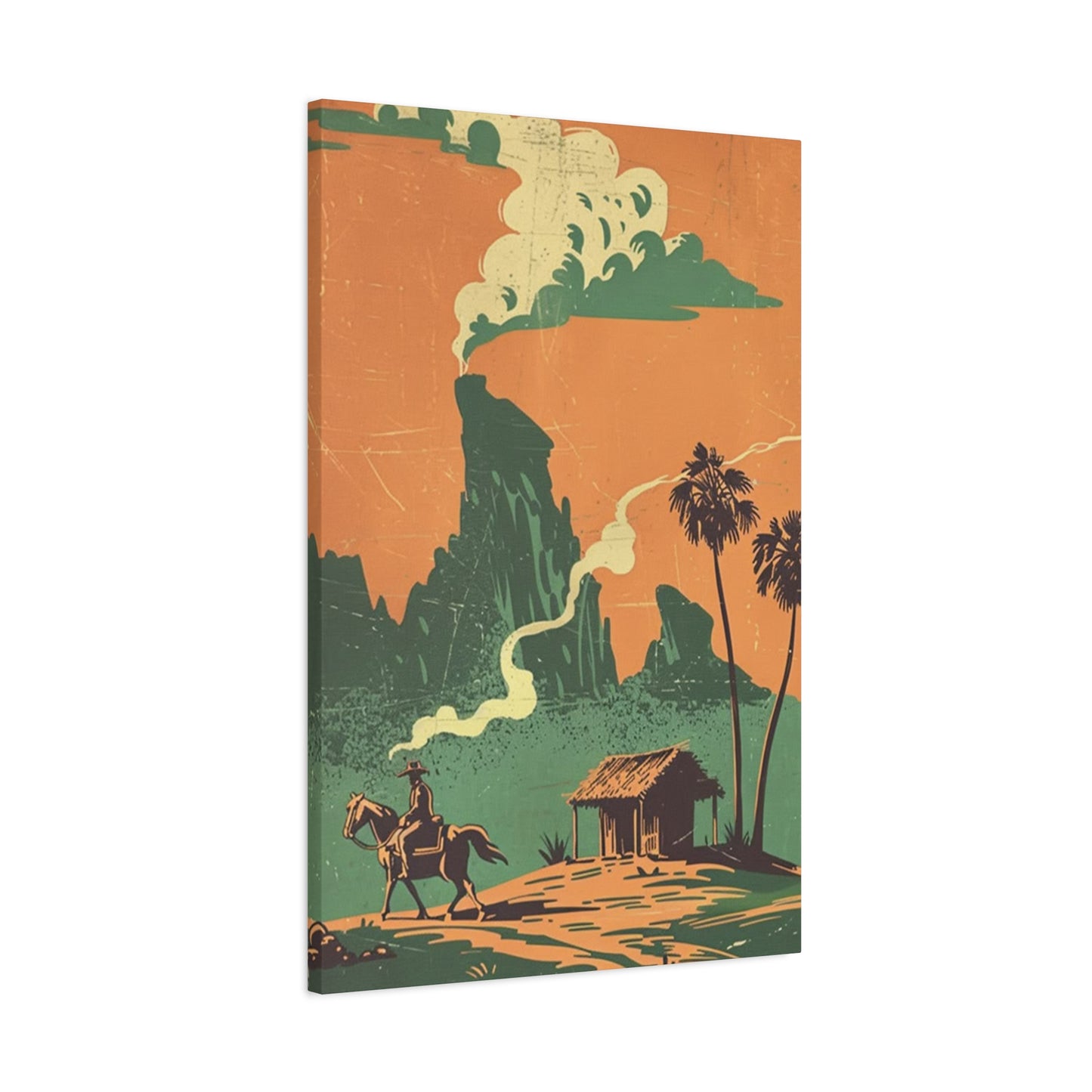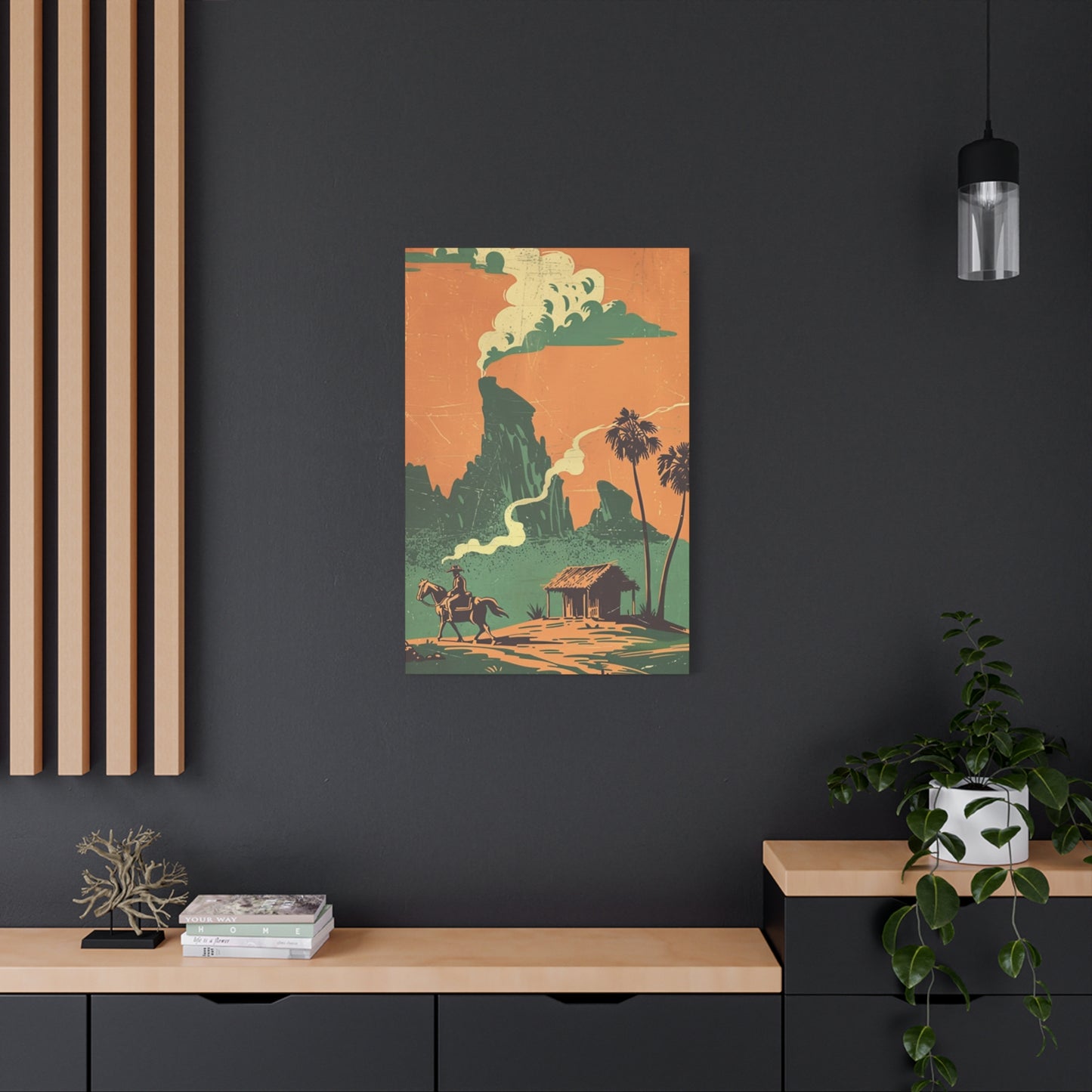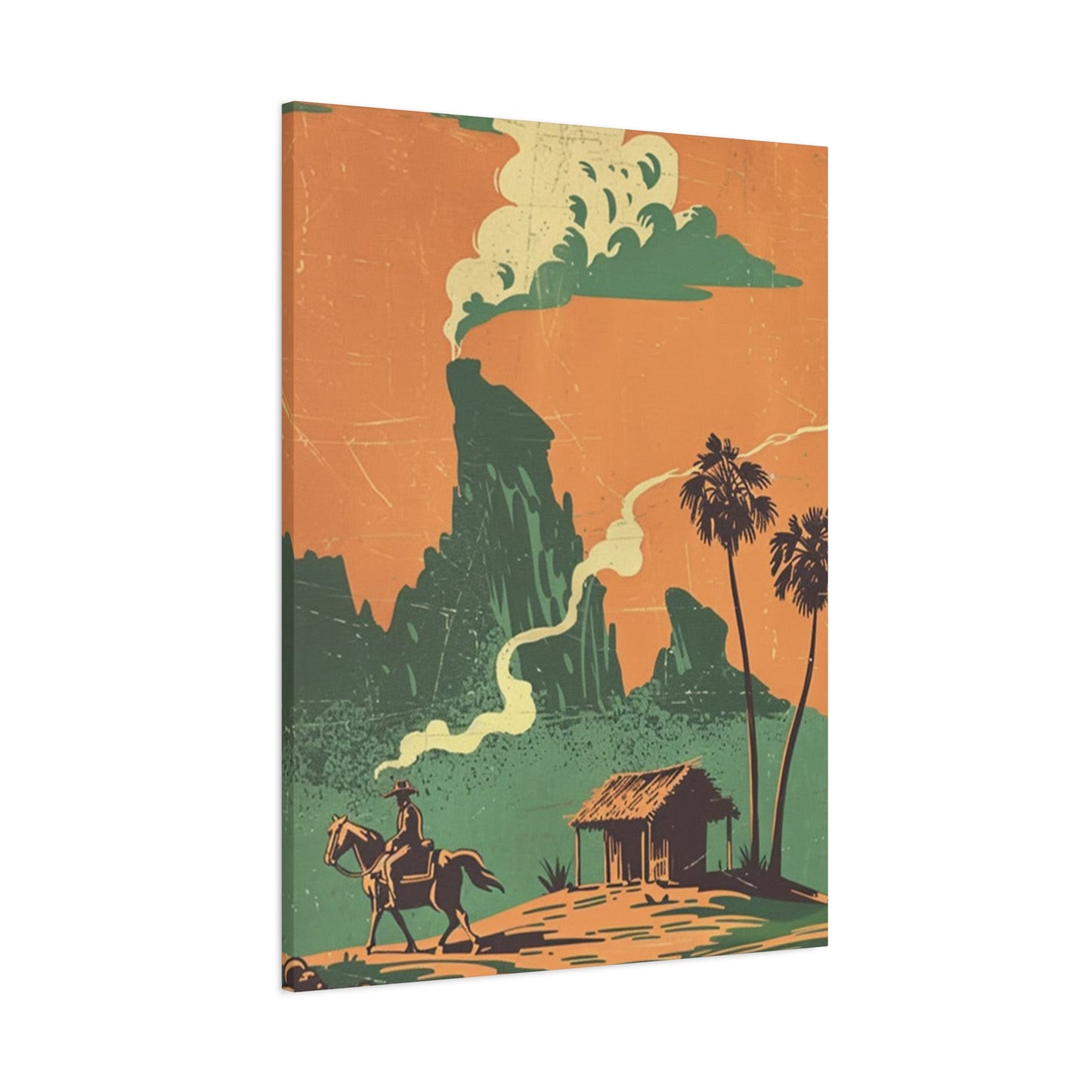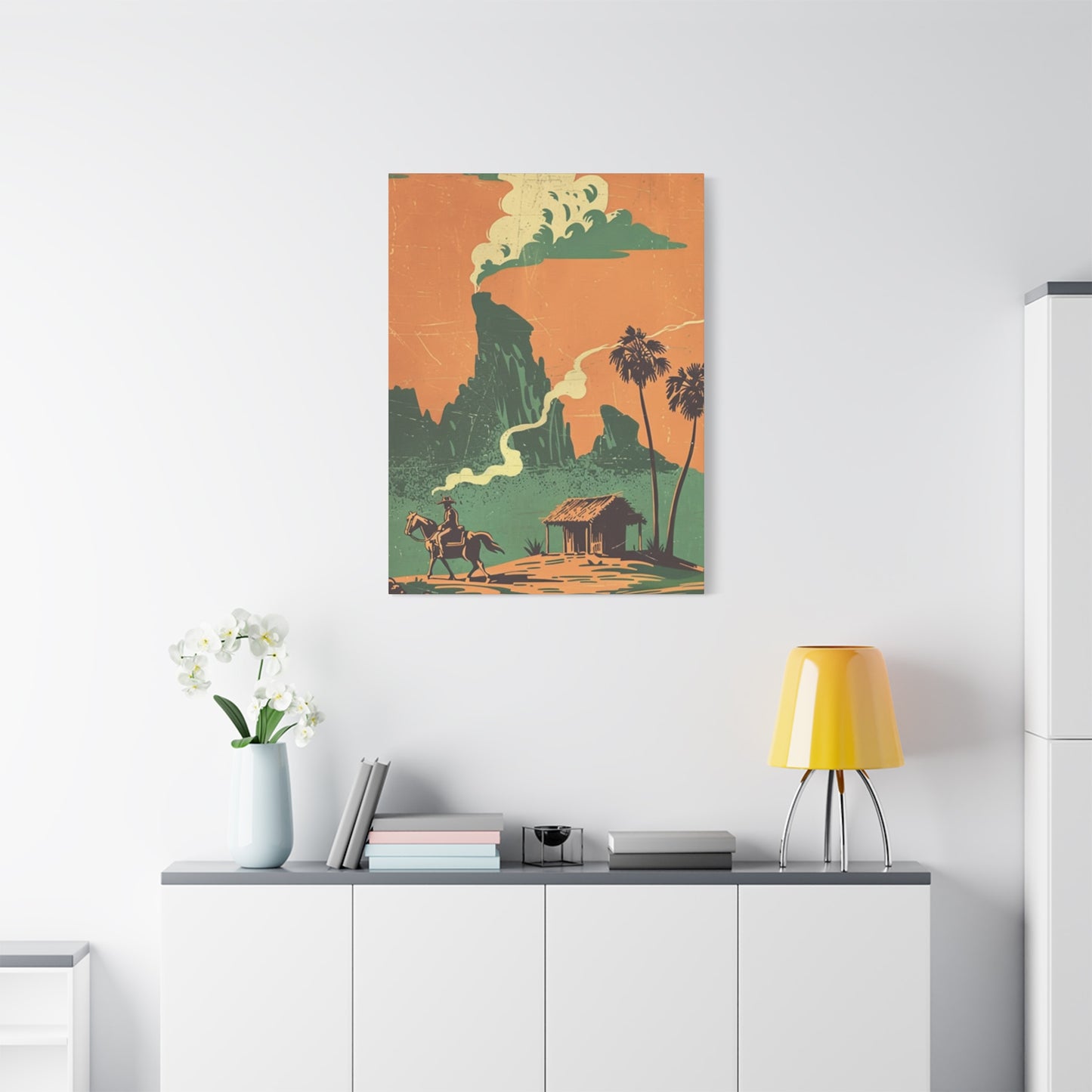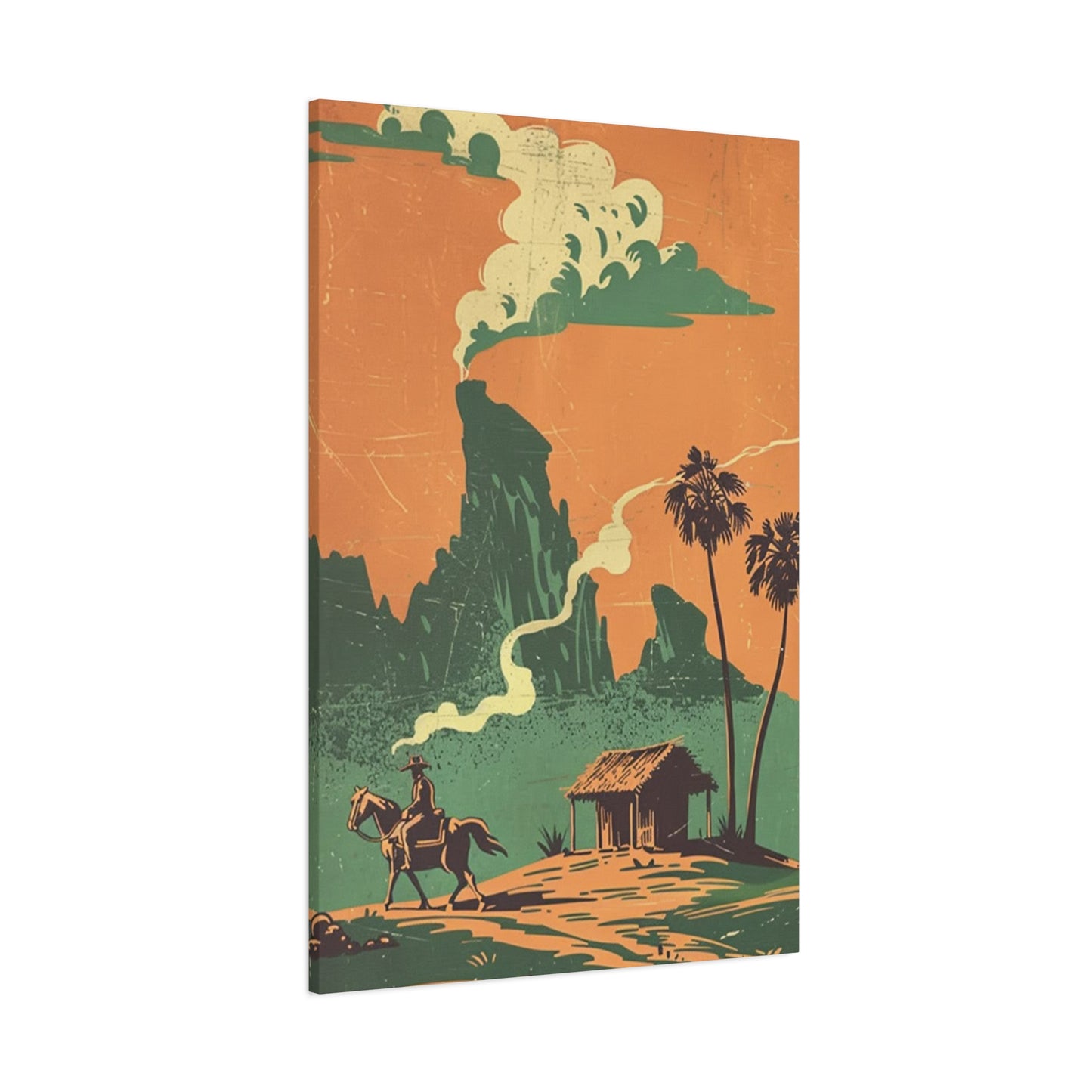Cowboys Southwest Wall Art: Bringing Authentic Western Heritage to Your Home
The American Southwest represents more than just a geographical region—it embodies a rich cultural heritage where rugged landscapes meet the enduring spirit of cowboy tradition. This unique blend of natural beauty and frontier history has inspired countless artists and homeowners to incorporate authentic western elements into their living environments. When discussing home decoration that captures this essence, few elements are as impactful and meaningful as carefully selected cowboy-themed artwork that reflects the genuine character of southwestern culture.
The appeal of southwestern cowboy artwork extends far beyond simple decoration. These pieces serve as windows into a bygone era when horsemen roamed vast open ranges, where honor and hard work defined daily existence, and where the connection between humans and nature remained unbroken. Today's homeowners increasingly seek authentic representations of this heritage, drawn to artwork that tells stories of resilience, adventure, and the timeless appeal of western lifestyle.
Modern collectors and decorators understand that genuine cowboy artwork from the Southwest region carries unique characteristics that distinguish it from generic western themes. The color palettes reflect the natural environment—warm terracotta tones, deep turquoise blues, golden sunset hues, and earthy browns that mirror the desert landscape. The subjects depicted often showcase real aspects of cowboy life: cattle drives across endless plains, solitary riders silhouetted against dramatic southwestern skies, and scenes of daily ranch work that defined this culture for generations.
The artistic movement celebrating southwestern cowboy culture has evolved significantly over the past century. Early artists who lived and worked alongside real cowboys brought authenticity to their work that continues to influence contemporary creators. These foundational artists understood the nuances of cowboy life—the way morning light caught on leather chaps, how dust clouds followed cattle herds, and the quiet dignity of men and women who made their living under vast southwestern skies.
Contemporary artists building on this foundation bring modern techniques and perspectives while maintaining respect for historical accuracy and cultural significance. They understand that creating meaningful cowboy artwork requires more than simply painting horses and riders. It demands appreciation for the values, challenges, and daily realities that shaped southwestern cowboy culture. This understanding translates into artwork that resonates with viewers who appreciate both artistic skill and cultural authenticity.
The market for southwestern cowboy artwork has expanded dramatically as more people discover the emotional and aesthetic appeal of these pieces. Collectors range from those with direct connections to western heritage to urban dwellers drawn to the freedom and authenticity that cowboy culture represents. This broad appeal has encouraged artists to explore various mediums and styles while maintaining the core elements that make southwestern cowboy art distinctive and meaningful.
When selecting cowboy artwork for home display, understanding the different styles and approaches helps ensure choices that will provide lasting satisfaction. Some pieces focus on historical accuracy, depicting specific events or periods in southwestern cowboy history with careful attention to detail in clothing, equipment, and settings. Other works take more interpretive approaches, using cowboy themes to explore broader concepts of freedom, tradition, and connection to the land.
The emotional impact of authentic southwestern cowboy artwork cannot be understated. These pieces often evoke feelings of nostalgia for simpler times, admiration for the courage and determination of frontier life, and appreciation for the natural beauty of southwestern landscapes. When displayed thoughtfully in homes, they create focal points that spark conversation and reflection while contributing to overall aesthetic appeal.
Understanding the cultural context behind southwestern cowboy artwork enhances appreciation for these pieces. The cowboy tradition in the Southwest developed through the meeting of various cultures—Spanish vaquero traditions, Native American horsemanship, and Anglo-American frontier practices. This cultural fusion created unique approaches to ranching, riding, and living that distinguished southwestern cowboys from their counterparts in other regions.
Historical Foundations of Southwestern Cowboy Culture
The roots of southwestern cowboy culture trace back centuries, beginning with Spanish colonizers who introduced cattle and horses to the Americas. These early ranchers, known as vaqueros, developed techniques and traditions that would later influence all aspects of American cowboy culture. The Southwest, with its vast open ranges and suitable climate, became a natural center for cattle ranching and the cowboy lifestyle that supported it.
Spanish colonial influence shaped not only practical aspects of ranching but also the aesthetic elements that continue to appear in southwestern cowboy artwork. The distinctive saddles, bridles, and clothing styles developed during this period combined functionality with decorative elements that reflected Spanish craftsmanship traditions. Artists depicting this era often incorporate these details to maintain historical accuracy while creating visually appealing compositions.
The Mexican period brought additional layers of cultural influence to southwestern cowboy traditions. Mexican ranchers, building on Spanish foundations, developed their own approaches to cattle management and horsemanship. The large land grants of this period created vast ranches that required skilled horsemen to manage cattle across enormous territories. This scale of operation influenced the development of distinctive southwestern cowboy practices and the visual imagery associated with this culture.
American expansion into the Southwest during the mid-1800s introduced new elements while preserving many existing traditions. Anglo-American settlers often adopted proven techniques from Mexican and Spanish ranchers while contributing their own innovations. This cultural blending created the unique southwestern cowboy culture that artists continue to celebrate today. The period following the Civil War saw massive cattle drives from Texas through the Southwest to railroad connections, creating the iconic images of cowboys driving herds across desert landscapes.
The development of major cattle trails through the Southwest provided artists with dramatic subject matter that continues to inspire contemporary works. These routes, including portions of the famous Chisholm Trail and the Goodnight-Loving Trail, witnessed countless scenes of cowboys working with cattle in challenging southwestern environments. Modern artwork often depicts these epic journeys, capturing both the grandeur and hardship of moving thousands of cattle across hundreds of miles of desert and mountain terrain.
Mining booms throughout the Southwest created additional opportunities for cowboys, as mining operations required steady supplies of beef and draft animals. Cowboys working in mining regions faced unique challenges different from those encountered on traditional ranches. They had to navigate relationships with diverse populations drawn to mining camps while maintaining their cattle in environments affected by mining activities. Artists exploring this aspect of southwestern cowboy history often create works that show the intersection of ranching and mining cultures.
Railroad construction across the Southwest marked both the end of the great cattle driving era and the beginning of new opportunities for cowboys. With rail connections, cattle could be shipped to markets without long overland drives, but this convenience came at the cost of the adventurous lifestyle that defined classic cowboy culture. Many artists focus on this transitional period, creating works that capture the bittersweet nature of progress and the changing role of cowboys in southwestern society.
The establishment of formal ranches throughout the Southwest provided more stable employment for cowboys but also changed the nature of their work. Instead of constant travel and adventure, ranch cowboys focused on managing cattle within defined boundaries, maintaining ranch facilities, and developing long-term relationships with specific properties. This evolution influenced artistic depictions of cowboy life, with some artists celebrating the stability and community aspects of ranch work while others mourned the loss of the nomadic freedom that characterized earlier periods.
Artistic Evolution and Styles in Cowboy Artwork
The artistic representation of southwestern cowboy culture has evolved through several distinct periods, each reflecting contemporary artistic movements while maintaining connection to authentic western themes. Early cowboy artists often worked directly from life, sketching and painting scenes they witnessed firsthand. This direct observation resulted in artwork with genuine authenticity that continues to influence contemporary creators.
Frederic Remington stands as perhaps the most influential early artist depicting southwestern cowboy life. His works combined technical skill with intimate knowledge of western culture, creating images that defined public perception of cowboys for generations. Remington's attention to detail in depicting equipment, clothing, and horse anatomy set standards that serious cowboy artists still follow today. His dramatic compositions showing cowboys in action—whether pursuing cattle, engaged in conflict, or simply riding across landscape—established visual conventions that remain powerful and appealing.
Charles Russell brought a different perspective to cowboy art, focusing on the daily life and character of working cowboys rather than purely dramatic scenes. Russell's backgrounds as a working cowboy provided him with insights that translated into artwork with exceptional authenticity. His paintings often captured quiet moments of cowboy life—men tending horses, sitting around campfires, or taking breaks during long days of work. This approach influenced generations of artists who sought to show the human side of cowboy culture rather than just adventure and conflict.
The influence of Native American artistic traditions on southwestern cowboy art reflects the complex cultural relationships that developed in frontier regions. Many cowboys worked alongside Native Americans, and this interaction influenced both practical aspects of ranching and artistic representations of western life. Artists sensitive to these cultural connections often incorporate Native American artistic elements into their cowboy works, creating pieces that acknowledge the multicultural nature of southwestern heritage.
Mexican artistic traditions also contributed significantly to the development of southwestern cowboy art styles. The vibrant colors and decorative approaches characteristic of Mexican art influenced artists depicting cowboy life in the Southwest. This influence appears in the use of bold color palettes, attention to decorative details on equipment and clothing, and compositional approaches that reflect Mexican aesthetic sensibilities.
Contemporary southwestern cowboy artists work within established traditions while exploring new approaches and techniques. Some focus on historical accuracy, conducting extensive research to ensure their depictions reflect authentic details of clothing, equipment, and settings from specific periods. Others take more interpretive approaches, using cowboy themes to explore contemporary issues or personal artistic visions while maintaining connection to western cultural foundations.
Photorealistic approaches to cowboy art have gained popularity as artists seek to create works with immediate visual impact. These highly detailed pieces often focus on specific moments or scenes, rendered with precision that rivals photography. While technically impressive, the best photorealistic cowboy art goes beyond mere technical display to capture emotional and cultural elements that make these scenes meaningful.
Impressionistic and loose painting styles offer different approaches to depicting cowboy life, emphasizing mood, atmosphere, and emotional content over precise detail. Artists working in these styles often focus on color relationships, light effects, and compositional elements that evoke feelings associated with cowboy culture rather than providing literal representations. This approach can be particularly effective for capturing the vast landscapes and dramatic lighting conditions characteristic of the Southwest.
Abstract interpretations of cowboy themes push artistic boundaries while maintaining connection to western culture. These works might use cowboy imagery as starting points for explorations of color, form, and composition that speak to universal themes of freedom, tradition, and connection to nature. While more challenging for viewers accustomed to representational art, abstract cowboy works can offer powerful emotional experiences and fresh perspectives on familiar themes.
Mixed media approaches allow contemporary artists to incorporate various materials and techniques into their cowboy-themed works. These might include traditional painting combined with collage elements, sculptural components, or even digital elements. Such approaches can create rich, layered works that speak to the complexity of southwestern cowboy culture and its continuing evolution in contemporary society.
Authentic Southwestern Visual Elements
Understanding authentic visual elements essential to southwestern cowboy culture helps in appreciating and selecting meaningful artwork for home display. These elements go beyond superficial western symbols to include specific details that reflect genuine southwestern heritage and the practical realities of cowboy life in desert and mountain environments.
The landscape itself provides the foundation for authentic southwestern cowboy art. Unlike the rolling grasslands associated with other western regions, the Southwest features distinctive terrain including vast deserts, dramatic mesas, deep canyons, and scattered mountain ranges. Artists familiar with this environment understand how these landscapes influenced cowboy life and work. The colors, lighting, and scale of southwestern landscapes create unique challenges and opportunities for cowboys that differ significantly from other western regions.
Desert vegetation plays crucial roles in authentic southwestern cowboy artwork. Saguaro cacti, palo verde trees, ocotillo, and various desert shrubs provide distinctive visual markers that immediately identify southwestern settings. Artists knowledgeable about desert ecology understand seasonal changes in this vegetation and how cowboys adapted their work to desert conditions. Spring desert blooms, for example, provided brief periods of abundant forage that influenced cattle management decisions and created spectacular visual displays that artists love to capture.
The quality of light in the Southwest creates unique challenges and opportunities for artists depicting cowboy life. Desert air provides exceptional clarity that allows distant mountains to appear sharp and detailed, while intense sunlight creates strong contrasts between light and shadow. Understanding these lighting conditions helps artists create convincing southwestern scenes and helps viewers appreciate the environmental factors that influenced cowboy culture in this region.
Traditional southwestern cowboy equipment differs from that used in other western regions, reflecting adaptations to desert conditions and cultural influences from Spanish and Mexican traditions. Saddles designed for southwestern use often feature different tooling patterns, leather treatments, and construction details suited to hot, dry conditions. Bridles, bits, and other equipment similarly reflect regional preferences and practical considerations unique to southwestern ranching.
Clothing worn by authentic southwestern cowboys incorporated practical considerations for desert work while reflecting cultural influences from various traditions. Broad-brimmed hats provided essential sun protection, while lightweight fabrics and specific cuts allowed air circulation in hot conditions. The influence of Mexican and Spanish traditions appears in decorative elements, color choices, and specific garment styles that distinguish southwestern cowboy clothing from that worn in other regions.
Horse breeds and types preferred by southwestern cowboys reflected the demands of desert and mountain terrain. These horses needed endurance for long-distance work, sure-footedness for rocky terrain, and ability to work effectively in extreme heat. Artists familiar with southwestern cowboy culture understand these requirements and depict horses that appear suitable for the demanding conditions of southwestern ranching.
Cattle breeds developed specifically for southwestern conditions also provide authentic visual elements for knowledgeable artists. Longhorn cattle, with their distinctive appearance and legendary toughness, became symbols of southwestern ranching. However, other breeds adapted to desert conditions also played important roles in southwestern cattle operations, and authentic artwork often reflects this diversity while showing cattle that appear suitable for harsh environmental conditions.
Architecture associated with southwestern ranching provides additional authentic visual elements for cowboy artwork. Ranch buildings constructed with local materials and adapted to desert conditions create distinctive visual characteristics that help establish authentic southwestern settings. Understanding traditional construction techniques, material choices, and functional requirements helps artists create convincing architectural elements in their cowboy scenes.
The integration of Native American cultural elements into southwestern cowboy culture provides rich material for authentic artwork. Trade relationships, shared knowledge about surviving in desert environments, and cultural exchange influenced both cowboy practices and visual culture. Artists sensitive to these relationships often incorporate authentic Native American elements into their cowboy works while avoiding stereotypes or cultural appropriation.
Seasonal changes in the Southwest create distinctive visual characteristics that authentic cowboy artists understand and incorporate into their works. Unlike regions with dramatic seasonal differences in vegetation, the Southwest experiences more subtle but significant changes that influenced cowboy work patterns. Understanding these seasonal variations helps artists create scenes that feel authentic to viewers familiar with southwestern environments.
Canvas and Print Selection Considerations
Selecting appropriate canvas and print options for southwestern cowboy artwork requires understanding how different materials and processes affect the final appearance and longevity of these pieces. The harsh lighting conditions common in southwestern homes—where intense sunlight streaming through windows can quickly fade inferior materials—make material quality particularly important for preserving artwork investments.
Traditional canvas materials offer classic presentation options that complement the timeless themes of cowboy artwork. Cotton canvas provides excellent color reproduction and has proven durability when properly prepared and mounted. Linen canvas offers superior archival qualities and a distinctive texture that many collectors prefer for serious artwork investments. Understanding the differences between these materials helps in making selections that will provide lasting satisfaction.
Modern synthetic canvas materials provide alternatives that may offer superior durability and color stability compared to traditional natural fiber options. Polyester-based canvases resist fading, moisture, and dimensional changes that can affect natural materials over time. For homes in environments with extreme temperature variations or high humidity levels, synthetic options may provide better long-term performance while maintaining excellent visual quality.
Print quality considerations extend beyond simply choosing high-resolution images. The printing process itself significantly affects final appearance and longevity. Giclée printing using archival inks on quality substrates provides museum-quality results that can last for decades without significant color changes. Understanding the differences between various printing processes helps in selecting pieces that will maintain their visual impact over time.
Color accuracy in reproductions of cowboy artwork requires careful attention to the printing process and materials used. The warm earth tones, brilliant sunset colors, and subtle desert hues characteristic of southwestern cowboy art can be challenging to reproduce accurately. Working with experienced printers who understand color management and use quality materials ensures reproductions that faithfully represent the original artwork.
Size considerations for cowboy artwork involve both aesthetic and practical factors. Large-scale pieces can create dramatic focal points that capture the vast scale of southwestern landscapes and the epic nature of cowboy culture. However, room proportions, ceiling heights, and viewing distances all affect how different sizes will appear in specific settings. Understanding these relationships helps in selecting pieces that will have maximum visual impact.
Mounting and framing options significantly affect the final presentation of cowboy artwork. Traditional frame styles that complement western themes without overwhelming the artwork require careful selection. The goal should be to enhance the artwork while maintaining focus on the cowboy subjects rather than drawing attention to decorative frame elements. Understanding various framing approaches helps in making choices that support the artwork rather than competing with it.
Gallery wrap options for canvas pieces provide contemporary presentation alternatives that eliminate the need for traditional frames while creating clean, modern appearances. This approach works particularly well for cowboy artwork with strong compositions that extend to the edges of the canvas. The wrapped edges can display continuation of the image or complementary colors that enhance the overall presentation.
Custom sizing options allow for pieces specifically proportioned to fit particular locations or complement existing elements in home decorating schemes. Many quality art suppliers offer custom printing services that can adjust compositions to work effectively at different scales or proportions. This flexibility helps in creating cohesive decorating approaches that incorporate cowboy artwork as integral elements rather than afterthoughts.
Protective treatments and coatings can extend the life of cowboy artwork while maintaining visual quality. UV-resistant coatings help prevent fading from sunlight exposure, while moisture barriers protect against humidity fluctuations. Understanding available protective options helps in making selections appropriate for specific display environments and expected longevity requirements.
Limited edition considerations add collectible value to southwestern cowboy artwork while ensuring exclusive ownership of particularly appealing pieces. Understanding numbering systems, edition sizes, and authentication methods helps collectors make informed decisions about investing in limited edition pieces. Certificates of authenticity and artist signatures add value while providing verification of legitimate limited edition status.
Rustic Home Integration Strategies
Successfully integrating southwestern cowboy artwork into rustic home environments requires understanding how these pieces interact with existing architectural elements, furniture choices, and overall decorating themes. The goal is creating cohesive environments where cowboy artwork enhances rather than conflicts with other design elements while maintaining authentic western character throughout the living environments.
Wood finishes and textures play crucial roles in creating appropriate settings for cowboy artwork. Rustic wood elements—whether in flooring, ceiling beams, or furniture—provide natural complements to the organic themes common in southwestern cowboy art. Understanding how different wood species, finishes, and aging characteristics interact with artwork helps in making selections that create harmonious overall appearances.
Stone and adobe architectural elements characteristic of southwestern construction provide excellent backgrounds for cowboy artwork. The natural textures and earth tones of these materials create visual harmony with the color palettes typically found in authentic cowboy art. Understanding how to use these architectural features as backdrop elements helps in positioning artwork for maximum visual impact while maintaining authentic southwestern character.
Leather furniture and accessories create natural connections to the practical materials used in cowboy culture. Quality leather pieces that show appropriate aging and wear patterns complement cowboy artwork by reinforcing themes of authenticity and connection to working ranch life. The key is selecting leather pieces that appear genuine rather than artificially distressed or overly refined for the rustic environments being created.
Textile choices significantly impact how cowboy artwork integrates into rustic home environments. Navajo rugs, Mexican serapes, and other traditional southwestern textiles provide authentic cultural connections while adding color and texture that complement cowboy themes. Understanding traditional patterns, color combinations, and weaving techniques helps in selecting textiles that enhance rather than compete with artwork displays.
Metal accents and hardware offer opportunities to reinforce western themes while providing functional elements throughout rustic homes. Hand-forged iron pieces, copper accents, and aged metal finishes echo the practical metalworking traditions associated with cowboy culture. These elements should appear functional rather than purely decorative to maintain authentic rustic character.
Lighting considerations for displaying cowboy artwork in rustic environments involve balancing adequate illumination with maintaining appropriate ambiance. Traditional lighting fixtures—such as wrought iron chandeliers, lantern-style wall sconces, or simple pendant lights—provide illumination while reinforcing western themes. The goal is creating lighting that allows artwork to be properly viewed while contributing to overall rustic atmosphere.
Color coordination throughout rustic homes displaying cowboy artwork requires understanding the natural color palettes that appear in both southwestern landscapes and traditional rustic materials. Earth tones, warm browns, desert colors, and sunset hues provide foundation colors that work with cowboy artwork while maintaining cohesive decorating themes throughout living environments.
Furniture arrangement strategies should create natural viewing angles and distances for displayed cowboy artwork while maintaining functional traffic patterns and seating arrangements. Understanding sight lines, conversation groupings, and activity zones helps in positioning both furniture and artwork for maximum enjoyment and practical use of living spaces.
Accessory selection provides opportunities to reinforce cowboy themes through smaller decorative elements that support larger artwork pieces. Authentic ranch tools, vintage spurs, quality cowboy hats, and similar items can create displays that enhance cowboy artwork while providing additional visual interest. The key is selecting accessories that appear authentic rather than touristic or mass-produced.
Room-by-room integration strategies recognize that different areas of rustic homes may require different approaches to incorporating cowboy artwork. Living areas might accommodate large, dramatic pieces that serve as focal points, while bedrooms might benefit from smaller, more intimate scenes. Understanding how different spaces function helps in selecting appropriate artwork for each location.
Color Palette and Design Harmony
Creating effective color harmony between southwestern cowboy artwork and surrounding home environments requires understanding the natural color relationships that exist in desert landscapes and traditional southwestern materials. These color connections provide the foundation for decorating approaches that feel authentic and visually cohesive while allowing cowboy artwork to achieve maximum impact.
Desert color palettes provide natural starting points for harmonious decorating schemes. The warm browns of desert soil, the silver-green of sage plants, the golden tones of desert grasses, and the deep blue of clear southwestern skies appear throughout authentic cowboy artwork. Understanding these natural color relationships helps in selecting paint colors, fabrics, and accessories that create seamless integration with displayed artwork.
Sunset and sunrise colors characteristic of southwestern skies offer dramatic but harmonious color options for rooms displaying cowboy artwork. The brilliant oranges, deep reds, golden yellows, and purple tones that appear in spectacular southwestern sunsets can be incorporated into decorating schemes through accent colors, textile choices, and accessory selections. The key is using these dramatic colors in appropriate proportions to enhance rather than overwhelm displayed artwork.
Earth tone foundations provide stable color bases that work with virtually all authentic southwestern cowboy artwork. Various shades of brown, tan, beige, and adobe colors create neutral backgrounds that allow artwork to take center stage while maintaining warm, welcoming atmospheres appropriate for rustic home environments. Understanding how to vary these earth tones prevents monotonous color schemes while maintaining overall harmony.
Turquoise and southwestern blue tones appear frequently in authentic cowboy artwork and traditional southwestern decorative arts. These colors can be incorporated into home decorating schemes through accent pieces, textiles, or architectural details that echo the colors appearing in displayed artwork. Understanding the cultural significance and traditional uses of these colors helps in incorporating them authentically rather than as superficial decorative elements.
Accent color strategies allow for introducing more vibrant colors that appear in cowboy artwork without overwhelming the overall decorating scheme. Bright red blankets, colorful pottery, or flowering plants can echo colors from artwork while providing visual punctuation throughout rooms. The goal is creating color echoes that connect artwork to the broader environment while maintaining balanced, harmonious appearances.
Seasonal color variations in southwestern environments can inspire changing decorative accents that keep rooms feeling fresh while maintaining harmony with permanently displayed cowboy artwork. Spring desert blooms, autumn grass colors, and winter sky tones provide natural color inspiration for seasonal decorating changes that complement rather than compete with artwork collections.
Natural material colors provide additional harmonious options for rooms displaying cowboy artwork. The honey tones of aged pine, the rich browns of leather, the gray tones of weathered stone, and the warm colors of copper and iron all appear in authentic southwestern environments and can be incorporated into home decorating schemes that support displayed artwork.
Pattern integration requires careful consideration when combining cowboy artwork with patterned elements in room decorating. Navajo patterns, Mexican tile designs, and traditional western textile patterns can complement cowboy artwork when used appropriately. The key is understanding scale relationships and ensuring patterns enhance rather than compete with artwork for visual attention.
Texture considerations affect color perception and overall visual harmony in rooms displaying cowboy artwork. Rough stone textures, smooth leather surfaces, woven textile patterns, and painted wall finishes all affect how colors appear and interact with displayed artwork. Understanding these relationships helps in creating environments where all elements work together harmoniously.
Contemporary color adaptations allow for updating traditional southwestern color palettes while maintaining harmony with authentic cowboy artwork. Modern neutral colors, updated accent tones, and contemporary material finishes can create fresh, current appearances while respecting the cultural authenticity of displayed cowboy artwork. The challenge is maintaining authentic character while avoiding dated or clichéd decorating approaches.
Sizing and Placement Strategies
Strategic placement of southwestern cowboy artwork requires understanding how different sizes and positions affect visual impact while considering practical factors such as furniture arrangements, traffic patterns, and architectural features. Successful placement strategies create focal points that enhance living environments while allowing artwork to be appreciated and enjoyed in daily use.
Scale relationships between artwork and architectural features significantly affect visual impact and overall room harmony. Large-scale cowboy artwork can compete effectively with high ceilings, substantial furniture pieces, and expansive wall areas, while smaller pieces may be overwhelmed in such settings. Understanding these scale relationships helps in selecting and positioning artwork for maximum visual effectiveness.
Eye-level positioning remains the standard guideline for artwork placement, but rustic home environments may require adjustments based on furniture arrangements and intended viewing situations. Artwork positioned for appreciation by seated viewers requires different height considerations than pieces intended for viewing while standing. Understanding typical viewing patterns in different rooms helps in positioning artwork for maximum enjoyment.
Grouping strategies allow for creating impressive displays using multiple pieces of cowboy artwork while maintaining visual coherence. Gallery wall arrangements can accommodate various sizes and formats of cowboy-themed pieces, creating dynamic displays that provide visual interest and allow for collecting flexibility. Understanding spacing, alignment, and visual weight helps in creating successful groupings that enhance rather than clutter wall areas.
Focal point creation using large-scale cowboy artwork can anchor room decorating schemes while providing dramatic visual impact. Positioning substantial pieces on prominent walls creates natural focal points around which other decorating elements can be arranged. Understanding sight lines, furniture arrangement, and architectural features helps in selecting optimal positions for major artwork pieces.
Corner placement strategies can maximize wall usage while creating intimate viewing experiences for cowboy artwork. Corner arrangements allow for creative lighting solutions and can make effective use of otherwise challenging architectural features. Understanding angular relationships and lighting considerations helps in creating successful corner displays that enhance rather than hide displayed artwork.
Above-furniture placement requires careful consideration of both visual and practical factors. Artwork positioned above seating areas, tables, or storage pieces should relate appropriately to the furniture below while maintaining safe clearances and appropriate visual proportions. Understanding these relationships helps in creating integrated displays that enhance both artwork and furniture arrangements.
Multiple-room coordination allows for creating cohesive cowboy artwork displays throughout homes while avoiding monotonous repetition. Different rooms may require different scales, subjects, or presentation approaches while maintaining overall thematic unity. Understanding traffic patterns, sight lines between rooms, and transitional elements helps in creating coordinated displays that enhance entire home environments.
Lighting integration with artwork placement ensures displayed pieces receive adequate illumination for proper appreciation while contributing to overall room ambiance. Natural light considerations, artificial lighting options, and seasonal variations all affect how positioned artwork will appear throughout different times and conditions. Understanding these factors helps in positioning artwork for optimal viewing under various circumstances.
Flexibility considerations for artwork placement allow for rearrangement and collection growth while maintaining well-designed room appearances. Positioning systems that accommodate changes, expansion, or seasonal rotation help maintain fresh, evolving displays while protecting wall surfaces and artwork investments. Understanding various hanging and positioning systems helps in creating flexible display solutions.
Safety and security factors affect artwork placement decisions, particularly for valuable pieces or in homes with active children or pets. Understanding appropriate heights, secure mounting systems, and protective considerations helps in positioning artwork for maximum security while maintaining visual accessibility and impact.
Cultural Authenticity and Historical Accuracy
Ensuring cultural authenticity and historical accuracy in southwestern cowboy artwork requires understanding the complex cultural heritage that shaped this tradition and recognizing the difference between genuine cultural representation and superficial stereotypes. Authentic cowboy art respects and accurately portrays the diverse influences that created southwestern cowboy culture while avoiding romanticized or inaccurate depictions that misrepresent this important American heritage.
Spanish colonial influences provided foundational elements of southwestern cowboy culture that continue to appear in authentic artwork. The techniques, equipment, and traditions developed by Spanish ranchers and their vaquero employees established practices that influenced all subsequent cowboy culture in the Southwest. Artists familiar with this history incorporate accurate details about Spanish colonial ranching practices, equipment designs, and cultural approaches that distinguished early southwestern cattle operations.
Mexican period contributions to cowboy culture included refinements and adaptations of Spanish traditions along with distinctly Mexican innovations in ranching practices and visual culture. Large Mexican land grants created extensive ranching operations that required sophisticated management techniques and equipment. Artists depicting this period understand the political, economic, and cultural factors that shaped Mexican ranching practices and their influence on developing cowboy traditions.
Anglo-American integration into existing southwestern ranching culture involved learning established techniques while contributing innovations and different approaches to cattle management. This cultural blending created the distinctive southwestern cowboy culture that combines elements from multiple traditions rather than representing a single cultural approach. Authentic artwork acknowledges this multicultural heritage rather than presenting cowboys as representing only one cultural tradition.
Native American relationships with cowboy culture varied significantly throughout the Southwest and changed dramatically over time. Some Native Americans worked as cowboys, while others maintained traditional lifestyles that occasionally intersected with ranching operations. Understanding these complex relationships helps in appreciating artwork that accurately portrays the diverse ways Native American and cowboy cultures interacted rather than relying on simplified or stereotyped representations.
Working conditions and daily realities of southwestern cowboy life differed significantly from romanticized popular depictions. Authentic artwork acknowledges the difficult working conditions, modest pay, and challenging lifestyle that characterized real cowboy work. Artists committed to accuracy portray the practical aspects of cowboy life—including the mundane daily tasks, equipment maintenance, and physical demands that occupied most of cowboys' time.
Equipment and clothing authenticity requires understanding how practical considerations and cultural influences shaped the tools and garments used by southwestern cowboys. Regional variations in equipment design, material availability, and climate considerations created distinctive southwestern approaches to cowboy gear that differed from equipment used in other western regions. Accurate artwork incorporates these regional differences rather than using generic western equipment details.
Seasonal and environmental accuracy in depicting southwestern cowboy life acknowledges how desert and mountain environments influenced work patterns, equipment choices, and daily routines. The extreme heat of southwestern summers, limited water availability, and seasonal variations in forage quality all affected cowboy work and lifestyle. Artists familiar with these environmental factors create scenes that appear authentic to viewers knowledgeable about southwestern conditions.
Economic and social realities of cowboy life included modest wages, limited social status, and often temporary employment that differed significantly from popular romantic depictions. Authentic artwork sometimes acknowledges these realities while still celebrating the positive aspects of cowboy culture such as independence, skill, and connection to the land. Understanding these social and economic factors helps in appreciating artwork that presents balanced rather than idealized views of cowboy life.
Cultural evolution and change over time affected southwestern cowboy culture significantly as railroads, mining operations, agricultural development, and urbanization changed the region. Authentic artwork sometimes explores these changes and their effects on cowboy life rather than presenting cowboy culture as static or unchanged over time. Understanding historical context helps in appreciating artwork that acknowledges the dynamic nature of southwestern cultural development.
Contemporary cultural connections between historical cowboy traditions and modern southwestern culture provide rich material for artists exploring the continuing relevance of cowboy heritage. Modern ranching operations, rodeo culture, western art traditions, and popular celebrations of cowboy culture all maintain connections to historical foundations while adapting to contemporary conditions. Artists exploring these connections create works that speak to both historical appreciation and contemporary relevance of cowboy culture.
Quality and Investment Considerations
Evaluating quality and investment potential in southwestern cowboy artwork requires understanding factors that affect both immediate visual appeal and long-term value retention. Quality considerations extend beyond simple aesthetic preferences to include technical execution, cultural authenticity, artistic significance, and practical durability factors that affect artwork ownership satisfaction over time.
Artist reputation and background significantly influence both quality assessments and investment potential for cowboy artwork. Artists with established reputations, gallery representation, and consistent sale records typically produce works with better investment potential than unknown or beginning artists. Understanding artist backgrounds, training, and career development helps in making informed purchasing decisions that consider both current appeal and future value prospects.
Technical execution quality affects both immediate visual impact and long-term durability of cowboy artwork. Professional artists understand color theory, composition principles, drawing accuracy, and material quality considerations that distinguish superior artwork from amateur efforts. Evaluating technical quality requires understanding artistic fundamentals and recognizing the difference between skilled execution and superficial appeal.
Material quality considerations significantly affect artwork longevity and investment value. Archival materials, lightfast pigments, quality canvas or paper, and appropriate preparation techniques ensure artwork will maintain its appearance over decades of display. Understanding material quality helps in selecting pieces that will provide lasting satisfaction while protecting investment value through superior durability.
Limited edition status and numbering systems affect collectible value for southwestern cowboy prints and reproductions. Understanding edition sizes, numbering conventions, and authentication methods helps in evaluating the exclusivity and potential investment value of limited edition pieces. Smaller edition sizes and clear documentation typically enhance collectible appeal and value retention.
Documentation and provenance add value and authenticity to cowboy artwork investments. Certificates of authenticity, artist signatures, gallery records, and exhibition history all contribute to artwork value and help establish authenticity for future resale considerations. Maintaining complete documentation protects investment value while facilitating future transactions.
Market trends and collecting patterns affect investment potential for different types of cowboy artwork. Understanding current collector preferences, emerging artists, and market developments helps in making informed purchasing decisions that consider both personal enjoyment and investment potential. Following auction results, gallery sales, and art market publications provides insights into value trends and collecting opportunities.
Condition assessment and preservation considerations affect both immediate enjoyment and long-term investment value of cowboy artwork. Understanding how to evaluate artwork condition, identify potential problems, and implement appropriate preservation measures helps in maintaining value while ensuring pieces remain attractive for display. Professional conservation services may be necessary for valuable pieces showing age or damage.
Insurance and protection strategies become important considerations for valuable cowboy artwork collections. Understanding coverage options, appraisal requirements, and protection measures helps in safeguarding investments while ensuring adequate compensation for losses. Regular appraisals and appropriate insurance coverage protect both financial investments and irreplaceable cultural artifacts.
Resale considerations may influence initial purchasing decisions for collectors interested in investment potential along with personal enjoyment. Understanding market preferences, dealer relationships, and auction opportunities helps in selecting pieces with good resale potential while avoiding purchases that may be difficult to sell in the future. Maintaining artwork in excellent condition and preserving documentation facilitates future resale opportunities.
Personal enjoyment versus investment potential requires balancing immediate satisfaction with longer-term considerations when selecting cowboy artwork. The best collecting approach often involves selecting pieces that provide personal satisfaction while offering reasonable investment potential. Understanding both personal preferences and market realities helps in making purchasing decisions that satisfy both immediate desires and long-term objectives.
Contemporary Artists and Movements
The contemporary southwestern cowboy art movement includes diverse artists working in various styles and approaches while maintaining connections to authentic western cultural traditions. Understanding current artistic developments, emerging talents, and evolving approaches to cowboy subjects helps in discovering artwork that combines traditional appeal with fresh perspectives and contemporary relevance.
Modern traditional artists continue classical approaches to cowboy subjects while incorporating contemporary techniques and perspectives. These artists often have direct connections to western culture through family background, personal experience, or extensive research that ensures authentic representation of cowboy life. Their work appeals to collectors who appreciate traditional approaches while seeking technically superior execution and fresh interpretations of familiar themes.
Contemporary realist artists bring photographic-quality techniques to cowboy subjects, creating works with immediate visual impact and strong popular appeal. These artists often focus on dramatic moments, spectacular lighting effects, and precise detail that showcases technical skill while celebrating cowboy culture. Understanding the difference between mere technical display and meaningful artistic content helps in evaluating contemporary realist work.
Conclusion
Cowboys Southwest wall art offers more than just decorative appeal; it serves as a powerful connection to the rich and rugged heritage of the American West. By incorporating these authentic pieces into your home, you invite the spirit of cowboy culture and the vast Southwestern landscapes into your daily life. Each artwork tells a story—whether it’s the lone rider silhouetted against a sunset, the dusty trails, or the iconic symbols of cowboy life like horses, boots, and hats. These visual narratives capture the essence of freedom, resilience, and adventure that define the Western way of life.
Moreover, Cowboys Southwest wall art adds a unique character and warmth to any space, blending rustic charm with artistic sophistication. Whether your home décor style leans towards traditional, rustic, or modern eclectic, these pieces can create a focal point that sparks conversations and evokes nostalgia for a bygone era. They reflect a timeless appreciation for nature, hard work, and the pioneering spirit, qualities that continue to inspire many today.
The versatility of cowboy-themed Southwest art also means you can easily mix and match various styles, mediums, and sizes to suit your personal taste and space requirements. From large canvas prints to metal art, wood carvings, or framed photographs, there’s a wide array of options to express your love for Western heritage. Supporting artists who specialize in this genre also helps preserve and promote cultural stories and traditions that might otherwise fade away.
In essence, Cowboys Southwest wall art transforms your living space into a celebration of history, culture, and artistry. It bridges the past and present, honoring the cowboy’s enduring legacy while enriching your environment with authenticity and style. If you seek to bring a piece of the West’s soul into your home, investing in this art form is both a meaningful and visually striking choice.

















